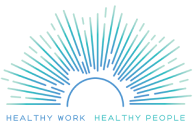Healthy Work Strategies
Healthy Work Strategies include workplace policies, programs, contract language, regulations and laws designed to reduce sources of stress at work (work stressors), and to make work and workers healthier. Each report below is a summary about how to improve the organization of work to reduce work stressors, such as:
Long work hours, bullying, sexual harassment, discrimination, threats of violence, understaffing, job insecurity, lack of supervisor or coworker support, work-family conflict, job demands, lack of job control, job strain, and “effort-reward imbalance.”
The types of Healthy Work Strategies below include:
Workplace research studies and programs to reduce work stressors
The research studies and programs, published in scientific journals, were selected because they were designed to reduce sources of stress at different workplaces in order to improve employee health (health promotion programs intended to change individual behaviors are not included). Many include a participatory “action” research focus, which means they involved workers, labor and management in a process that was intended to create positive change. These studies document the effects of workplace programs and policies and provide important details about the process of changing working conditions—so that you can see if such a process might work in your workplace or industry.
Health Care
Reducing work stress and improving the mental health of hospital workers (Quebec, Canada)
Manufacturing
Job redesign at a sweets manufacturing company in England
Public Sector Workers
Increasing job control and reducing other job stressors among call center workers in England
Redesigning the jobs of postal workers in Uppsala, Sweden
Supervisor Support and Work-life balance
Teachers/Education
Workplace policies and programs to reduce job stress among K-12 education staff (U.S.)
Transit Workers – bus drivers
Action research intervention with urban bus drivers in Copenhagen, Denmark
Bathroom access for bus drivers in the US and Canada
Intervention to reduce job stress among urban bus drivers in Stockholm, Sweden
Preventing threats and violence against bus drivers
Programs and policies to reduce work stress among bus drivers in the United States and Canada
Workplace bullying/discrimination/violence
A training program for workers and managers on reducing male bullying and workplace violence (U.S.)
Labor-Management Contracts
The reports below are examples of labor-management contracts that include specific provisions intended to improve working conditions and that may make work healthier as well. Many of these collective bargaining efforts were not intended to improve workers’ health and have not been scientifically studied to determine their effectiveness, however they are legally binding and enforceable.
Contract Language to Reduce Job Stress in Education & Healthcare (Summary)
Jim Beam workers achieve better work-life balance through new labor-management contract
SAG-AFTRA creates code of conduct to prevent sexual harassment in the workplace
Trade union actions to prevent psychosocial risks in healthcare (E.U.)
Laws and Regulations
Many of these legislative efforts were initiated through the efforts of certain industries, unions or worker groups to improve aspects of the work environment, but were not primarily to improve workers’ health and have not been scientifically studied to determine their effectiveness. However, laws and regulations also typically reach more people than the workplace-based programs that have been studied. These reports were based on news stories and reports from specific unions and/or industry publications.
A national standard for psychological health and safety in the workplace in Canada
Government labor inspectors’ role in protecting workers’ mental health in Quebec
Job redesign and national labor protections have positive effects on worker health and the economy
Laws and regulation to prevent workplace violence in healthcare
Laws prohibiting mandatory overtime for nurses
Laws to improve nurse staffing levels in hospitals in the U.S.
Legislation to prevent psychosocial risks in healthcare (E.U.)
Legislation to prevent workplace sexual harassment
Legislation to reduce job stress in education & healthcare (summary)
Stress Check: A national policy in Japan for prevention of workplace stress
Reducing COVID-19-related work stressors
The following case studies summarize some of the efforts by different groups and organizations to reduce COVID-related work stressors. We will be continuously updating this section.
For further COVID-19 worker resources, visit UCLA’s Labor Occupational Health & Safety Program page on this topic.
If you have any questions or comments about these reports, or have updates or new programs, policies, or laws that you would like us to include, please feel free to contact us.
Acknowledgements
We would like to thank and acknowledge the many people who wrote and reviewed these case studies, not the least of which Paul Landsbergis, PhD, MPH, Principal Investigator for the Healthy Work Toolkit, who supervised the development, review and completion of each case study, in addition to researching and writing a number of them.
This project was made possible, in large part, by the dedication of Dr. Landsbergis’ SUNY Downstate School of Public Health graduate students, who researched and drafted many of the case studies, and whose time was funded by a grant from the Center for Social Epidemiology. We greatly appreciate and acknowledge:
- Jeanine Botta
- Daphne Brown
- Rivka Franklin
- Yocheved Halberstam
- Christopher Jimenez
- Marie-Anne Rosemberg
- Elina Shtridler
Additionally, for their review and helpful comments, we warmly thank and acknowledge:
- Alex Bryson
- Bill Borwegen
- Mark Catlin
- Ellen Cobb
- Marnie Dobson
- Mahée Gilbert-Ouimet
- Leslie Hammer
- David Holman
- Katherine Lippel
- Jane Lipscomb
- Minnesota Association of Public Employees
- New York State Nursing Association
- Jonathan Rosen
- Glenn Shor
- Jan Thomason
- Xavier Trudel
- Kurt Wahlstedt






